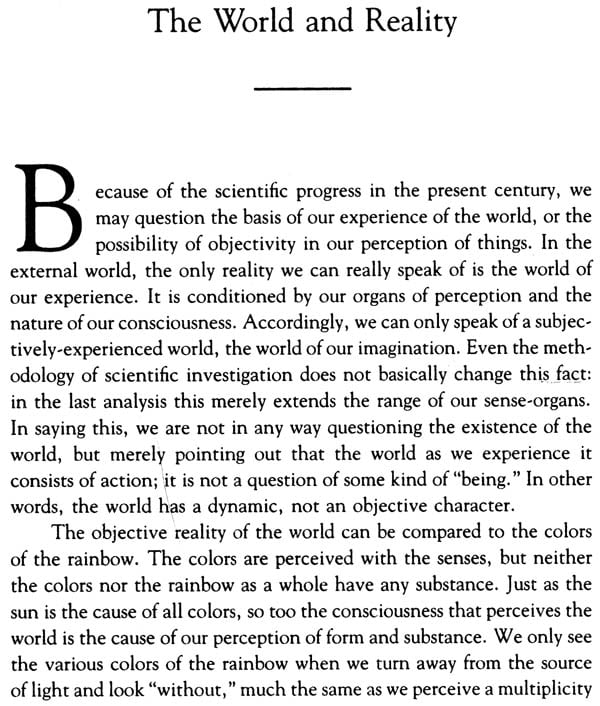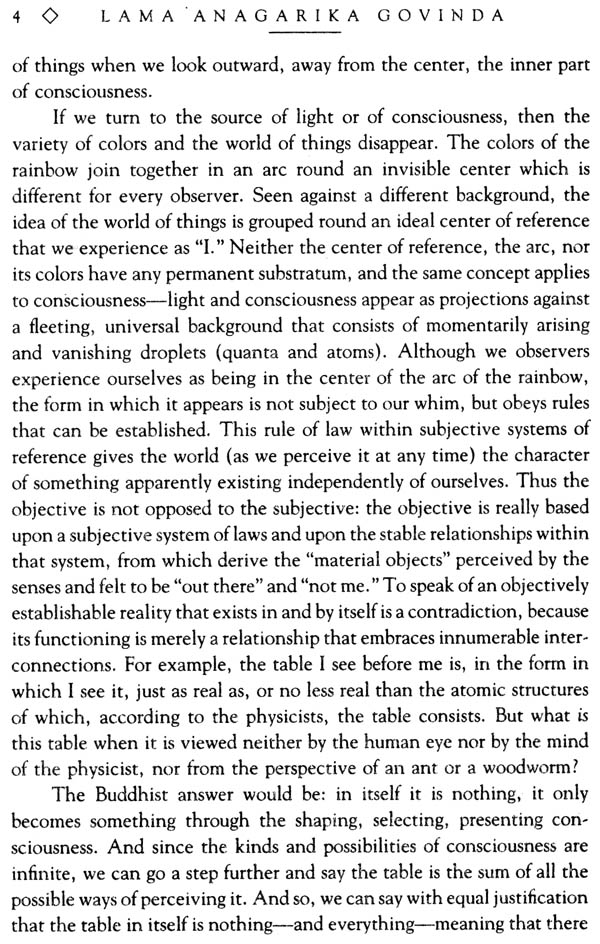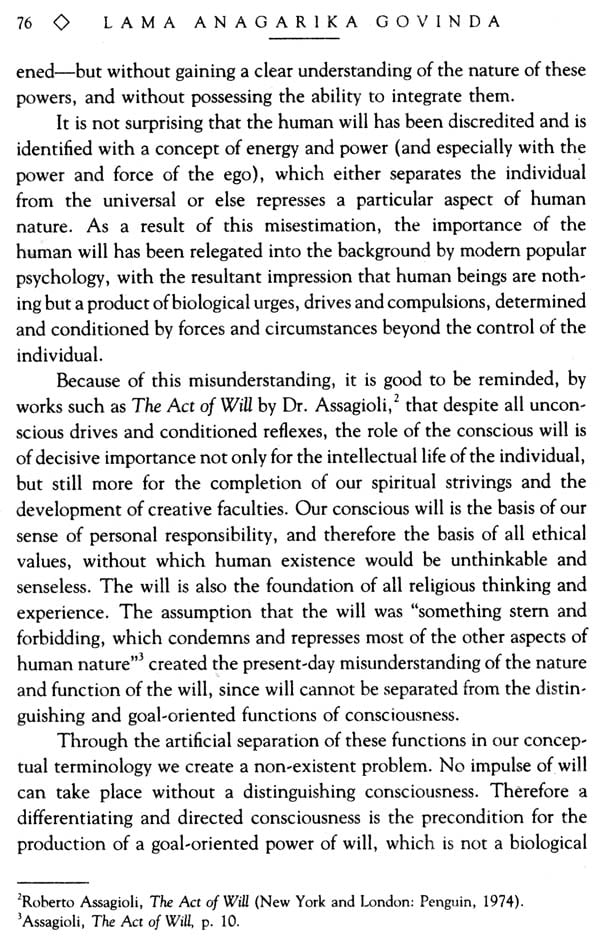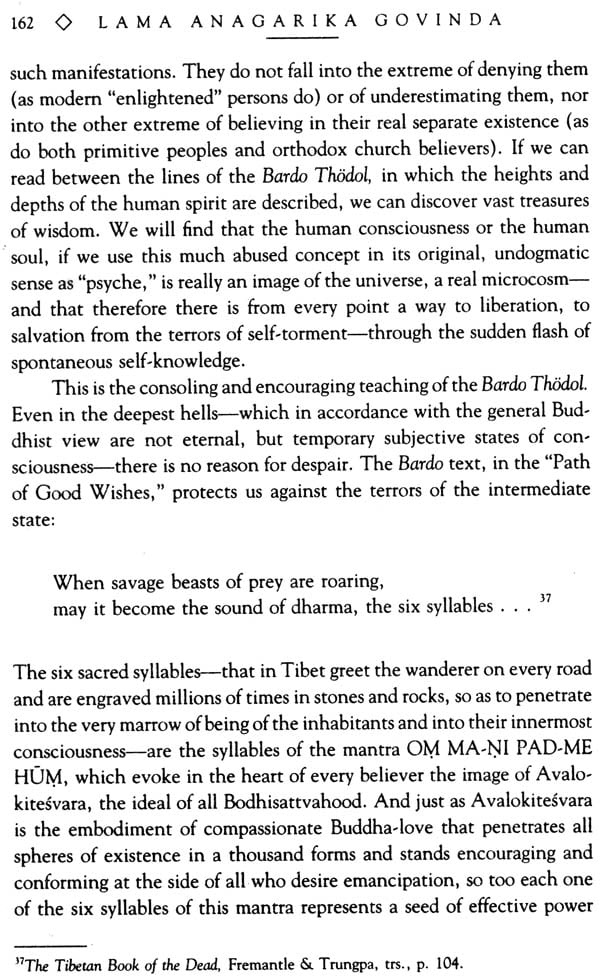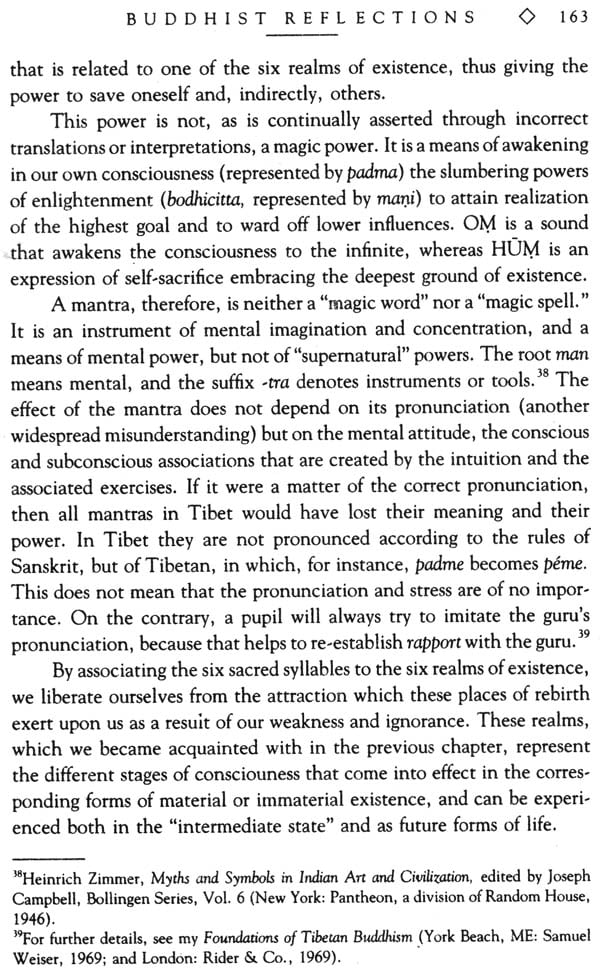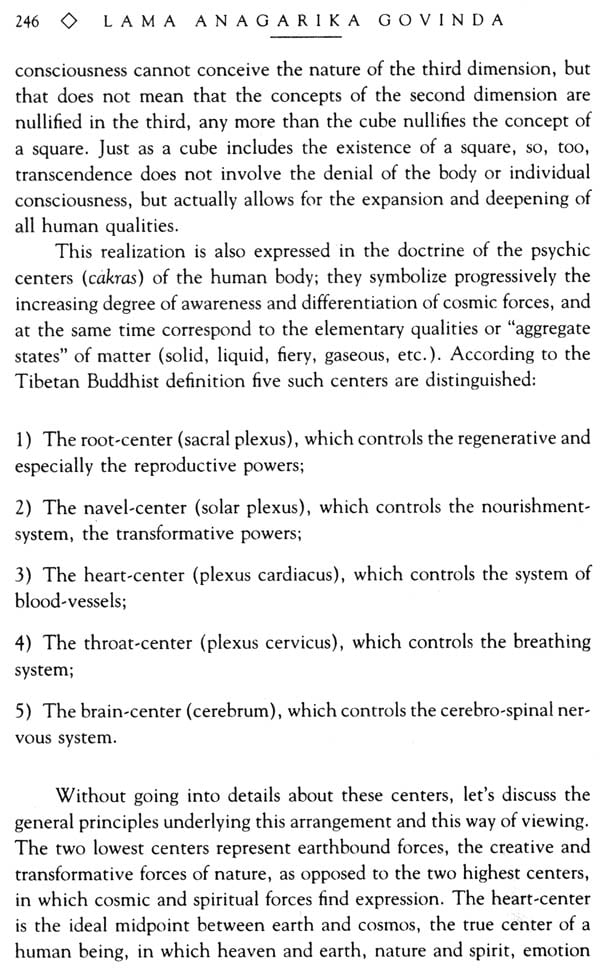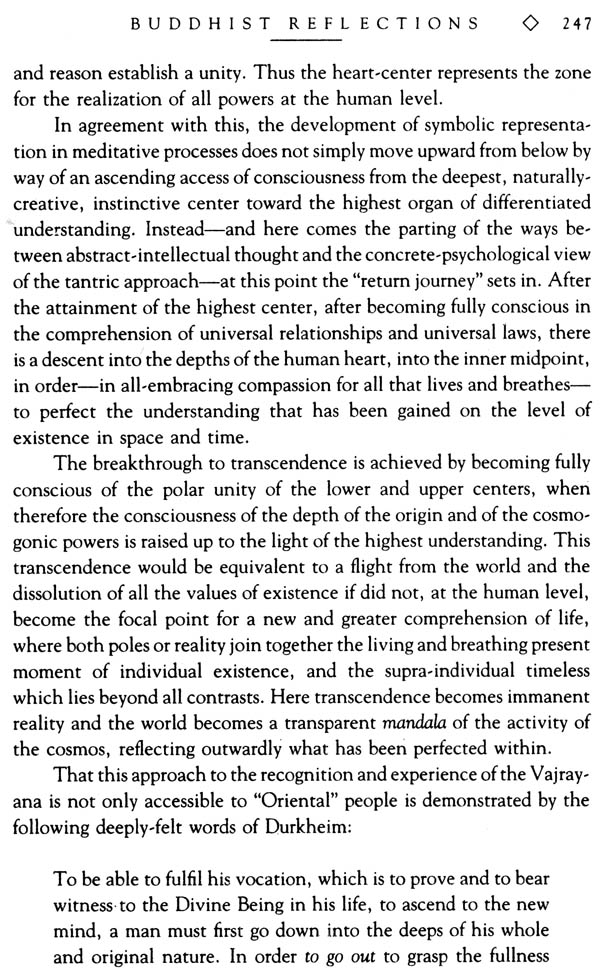
Buddhist Reflections
Book Specification
| Item Code: | NAU288 |
| Author: | Lama Anagrika Govinda |
| Publisher: | Motilal Banarsidass Publishers Pvt. Ltd. |
| Language: | English |
| Edition: | 2007 |
| ISBN: | 9788120830950 |
| Pages: | 250 |
| Cover: | PAPERBACK |
| Other Details | 8.50 X 5.50 inch |
| Weight | 280 gm |
Book Description
Lama Govinda provides an exciting overview of contemporary Buddhist philosophy for the modern student. He shares his insights into Indian and Tibetan Buddhist traditions concerning the nature of reality, the development of consciousness, death and rebirth, faith and tolerance, and the significance of meditative and ritual practices.
In depicting the Tantric Buddhist approach that utilizes ancient mantras and mandalas to produce meditative absorption in a unified experience of sound, color and form, Lama Govinda pays homage to a spiritual edifice of great beauty and complexity.
Lama Govinda invokes a multidimensional vision of Buddhist understanding that includes the rational perspectives of modern science and psychology, but goes far beyond them. In building a conceptual bridge between Eastern mysticism and Western philosophy, he discusses the work of Assagioli, Teilhard de Chardin and von Durkheim, among others. There are also chapters of concern to Western society, such as the expansion of consciousness through drugs and the nature of attachment and suffering in love relationships. The material presented here was gathered from lectures and articles written by Lama Govinda shortly before his death in 1985, providing readers a close look at his warmth and lovingness.
LAMA ANAGARIKA GOVINDA lived most of his adult life in Sri Lanka, India and Tibet. He studied and practiced several Buddhist traditions, but-‘was viewed as a significant representative and interpreter of Tibetan Buddhism, spending over 20 years studying at the feet of masters in Tibetan hermitages and monasteries. He was committed to not only living a spiritual life but passing on his understanding to Western students exploring the spiritual path. His experiences as a pioneer in Buddhism provides a modern link between East and West.
Lama Anagarika Govinda was born Ernst Hoffman in Germany in 1898. He was both an artist and an author. He wrote the well-known Foundations of Tibetan Mysticism, The Inner Structure of the I Ching, A Living Buddhism for the West, and The Way of the White Clouds. Lama Govinda died in 1985.
There is a Tibetan prophecy attributed to the great Indian sage and guru Padmasambhava: "When the iron bird flies, the Dharma (the Buddhist teaching) will go to the west." It was mainly through European scholars that, about the end of the last and the beginning of the present century, the West came to learn about the teachings the Buddha (the Awakened One), the man who proclaimed his gospel of liberation from suffering and of the highest enlightenment, two thousand five hundred years ago.
This message was conveyed without the sword. It was laid before us for our critical judgment with the Buddha’s invitation: "Come and see!" And now, without the aid of any loud missionary propaganda, Buddhism has taken root in the West, has found many youthful enthusiasts, and has become a factor in our intellectual life that can no longer be ignored. One man—from the stillness of his hermitage in the foothills of the Himalayas—who has become one of the leading Buddhist personalities in the West is Lama Anagarika Govinda. He is a recognized Buddhist scholar, interpreter and spiritual teacher, and his works which are continually in print in German, English, French, Italian, Spanish, Portuguese, Swedish, Dutch and Japanese editions—have reached many millions of readers.
Having been raised in a European cultural background, he was as he wrote at the age of 21 in 1919—at first an enthusiastic follower of Christianity; but soon, after wrestling intensively with the God- concept, he turned away from Christianity and found the type of religious experience that was congenial to him in Buddhism. His scientific methodology was formed by European universities, where he studied philosophy, architecture and, later, archaeology. His education was further enriched by language studies (in addition to European languages, he studied Pali, then Sanskrit, Tibetan, and the rudiments of Chinese) and also by painting.
Asan active member of the Buddhist movement in the ’20s (principally in Germany and Italy), in 1928 he went to Sri Lanka and joined the European monastic community there under the Ven. Nyanatiloka Thera under the name of Brahmacari Govinda. A year later he took ordination in Burma as an Anagiarika. Finally, in 1931, he met with the great Tibetan teacher Tomo Geshe Rimpoche in Darjeeling, and this meeting was to be decisive for his later life.
The Anagarika, whose thinking had previously been entirely conditioned by the culture of Europe, now opened up fully to the Asian way of thinking that surrounded him. He registered its differentness, absorbed it and made it his own; then, in the course of many years of assimilation, he completed that integration of thinking and feeling that has now made him such a great interpreter for the occidental Buddhism of today.
He spent more than thirty years in Ceylon, Burma, Sikkim, Tibet and India—as student, scholar, university teacher, painter and hermit before returning to the West where he initiated a course of lecturing activity that was to lead him right round the world. The essays, lectures and conversations included in this book give some understanding to the range of Lama Govinda’s creative activity and influence. They are aimed at different audiences, addressing each according to its capacities, always opening up fresh perspectives. The result is a gradually unfolding survey of Buddhism for the present age, one not caught up in the dogmatic disputes of the schools.
This book is distinguished not only by its convincing scholarship, the author’s narrative skill, and the brilliant synopses that derive from the wisdom of a life fulfilled and rich in activity and contemplation alike—it is above all the compassionate understanding and the responsible humanity that appeal so directly to us—even when the author shows himself opposed to all dogmatically fixed positions, some hallowed by long tradition.
When the Buddha, after his enlightenment, entered the Deer Park at Benares, he was just a solitary wanderer a pilgrim like thousands of others who daily visited the holy city. He had been deserted by his friends and given up by his family. No one knew of his great victory, there was no visible sign to convince the world. And even if it had been possible to impress those about him by signs and wonders, the Buddha would have been the last to use such means. And yet, this solitary pilgrim brought into the world, concealed in his heart, the light of an understanding that was to change the face of one part of the human race.
It is a good thing to bear in mind that those who have proved stronger than the might of kings with their armies, stronger than time and even than death, have also wandered, just like so many of us, alone and deserted in the unpitying desert of Samsdra.' This can give us the Samsdara is often misleadingly translated as "world of transmigration" or "phenomenal world." But samsdra is not "world" in the ordinary sense, but the subjectively experienced world of unenlightened beings. Nirvana as the opposite of samsdra is therefore neither a place nor a metaphysical principle, but the state of experience of one who is fully enlightened and who recognizes the world, without passion, for what it really is. Thus, assurance that we, too, bear the seed of enlightenment within us, and that it depends on our efforts alone whether we bring it to germination and allow its fruits to develop. This faith in our own indwelling powers is the only faith that the Buddha asks of us. The Buddha’s first words after his enlightenment were:
Apdrutd tesam amatassa dvara; ye sotavanto, pamuficantu saddham.
Opened are the doors of the Deathless (amatassa); Let those who have ears to hear put forth faith.’
That the Buddha did not expect to find this "faith" in the easy credulity of the masses is shown by the fact that he made the first proclamation of his teaching to those former companions who had lost their trust in him, and who regarded him with the deepest suspicion. When they saw the Buddha approaching through the Deer Park, they decided neither to greet him nor to make him welcome, but to treat him with contemptuous indifference. But what happened? As the Buddha came nearer, one after the other rose and went toward him. His face showed his great spiritual victory, his eyes revealed the profound brilliance of one who has passed through the mysteries of life and death and overcome; his whole personality radiated bliss, as if the inner light shone through the outer form.
Never did the expression and behavior of a human being reveal a greater sincerity and assurance, born of the wish to proclaim to others this supreme realization, for the benefit of all living beings, than did those of the Buddha in that historic moment. It was this perfect oneness of his whole being that gave his words the power of conviction which was to endure for thousands of years, evoking an echo in ug as strong as if they had only just been spoken. The bliss that the Buddha enjoyed silently in the solitude of the forests during the weeks that passed after his enlightenment is contained in his solemn pronouncement to the five ascetics in the Deer Park:
Lend an ear, o monks! Deliverance from death has been found.
It is strange how this happy message has been almost forgotten by Buddhists today, especially by those in the West who have tried to read pessimism or a life-denying rationalism into the Buddha’s teaching. But this very first utterance of the Buddha’s, beginning with such words of triumph, clearly shows the basic position of his teaching: the idea of a middle path equidistant from a life of selfish enjoyment or one of self- torment and misery. Being freed from these extremes, it gives vision to the eye and clarity to the mind, leading to peace, understanding and enlightenment.
The requirement to avoid extremes applies to practical life as well as to that of the mind, and it led to a new way of thinking, in fact to a new system of logic. From it there were to arise the great philosophies of Asia, the core of which is the idea of the conditionality of all things. Rightly understood, these ideas could be of immense value for our world today. But as yet we are far from an attitude of understanding that would lead to a living kinship with all that breathes and to the creation of genuine tolerance.
The fact that tolerance can go hand in hand with utter conviction has been demonstrated through the practice of the middle way in the history of Buddhism. And thus I believe that Buddhism is especially suited to the task of creating peace and harmony in the modern world.
